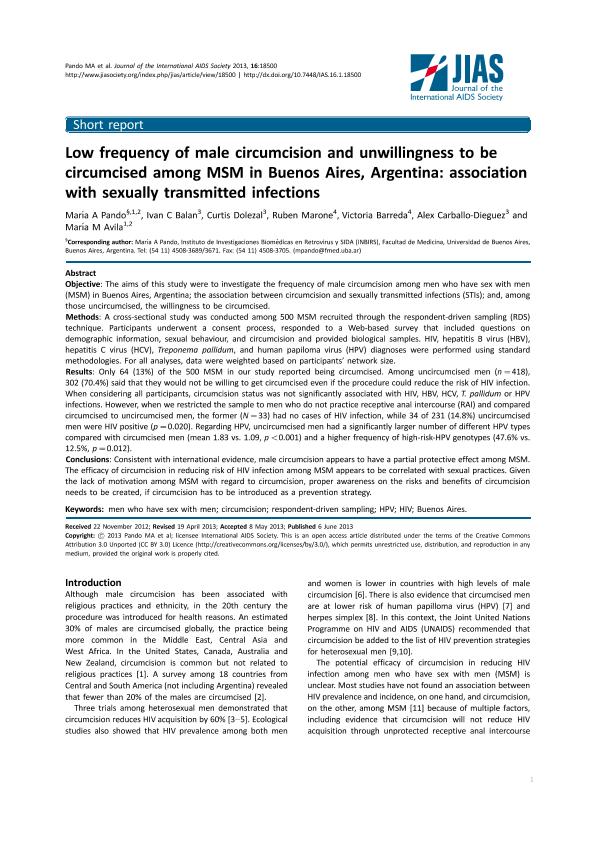Artículo
Low frequency of male circumcision and unwillingness to be circumcised among MSM in Buenos Aires, Argentina: association with sexually transmitted infections
Pando, María de los Ángeles ; Balan I; Dolezal C; Marone R; Barreda V; Carballo Dieguez A; Ávila, María Mercedes
; Balan I; Dolezal C; Marone R; Barreda V; Carballo Dieguez A; Ávila, María Mercedes
 ; Balan I; Dolezal C; Marone R; Barreda V; Carballo Dieguez A; Ávila, María Mercedes
; Balan I; Dolezal C; Marone R; Barreda V; Carballo Dieguez A; Ávila, María Mercedes
Fecha de publicación:
06/2013
Editorial:
International AIDS Society
Revista:
Journal of the International AIDS Society
ISSN:
1758-2652
Idioma:
Inglés
Tipo de recurso:
Artículo publicado
Clasificación temática:
Resumen
Objective: The aims of this study were to investigate the frequency of male circumcision among men who have sex with men (MSM) in Buenos Aires, Argentina; the association between circumcision and sexually transmitted infections (STIs); and, among those uncircumcised, the willingness to be circumcised. Methods: A cross-sectional study was conducted among 500 MSM recruited through the respondent-driven sampling (RDS) technique. Participants underwent a consent process, responded to a Web-based survey that included questions on demographic information, sexual behaviour, and circumcision and provided biological samples. HIV, hepatitis B virus (HBV), hepatitis C virus (HCV), Treponema pallidum, and human papiloma virus (HPV) diagnoses were performed using standard methodologies. For all analyses, data were weighted based on participants’ network size. Results: Only 64 (13%) of the 500 MSM in our study reported being circumcised. Among uncircumcised men (n=418), 302 (70.4%) said that they would not be willing to get circumcised even if the procedure could reduce the risk of HIV infection. When considering all participants, circumcision status was not significantly associated with HIV, HBV, HCV, T. pallidum or HPV infections. However, when we restricted the sample to men who do not practice receptive anal intercourse (RAI) and compared circumcised to uncircumcised men, the former (N=33) had no cases of HIV infection, while 34 of 231 (14.8%) uncircumcised men were HIV positive (p=0.020). Regarding HPV, uncircumcised men had a significantly larger number of different HPV types compared with circumcised men (mean 1.83 vs. 1.09, p<0.001) and a higher frequency of high-risk-HPV genotypes (47.6% vs. 12.5%, p=0.012). Conclusions: Consistent with international evidence, male circumcision appears to have a partial protective effect among MSM. The efficacy of circumcision in reducing risk of HIV infection among MSM appears to be correlated with sexual practices. Given the lack of motivation among MSM with regard to circumcision, proper awareness on the risks and benefits of circumcision needs to be created, if circumcision has to be introduced as a prevention strategy.
Archivos asociados
Licencia
Identificadores
Colecciones
Articulos(INBIRS)
Articulos de INSTITUTO DE INVESTIGACIONES BIOMEDICAS EN RETROVIRUS Y SIDA
Articulos de INSTITUTO DE INVESTIGACIONES BIOMEDICAS EN RETROVIRUS Y SIDA
Citación
Pando, María de los Ángeles; Balan I; Dolezal C; Marone R; Barreda V; et al.; Low frequency of male circumcision and unwillingness to be circumcised among MSM in Buenos Aires, Argentina: association with sexually transmitted infections; International AIDS Society; Journal of the International AIDS Society; 16; 6-2013; 18500-18501
Compartir
Altmétricas



